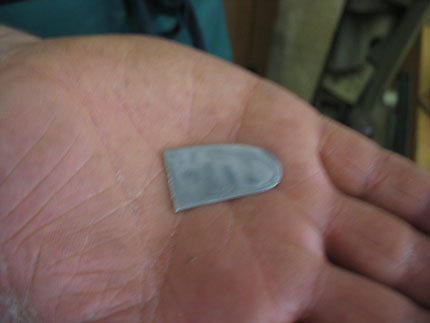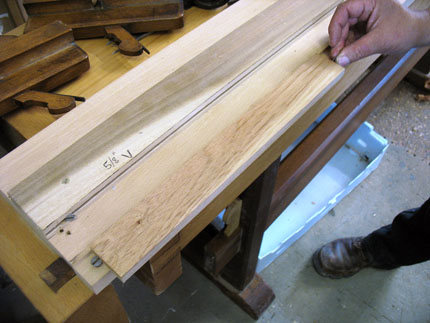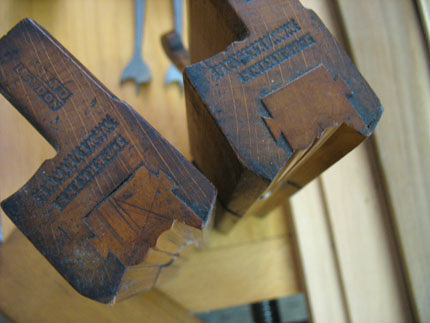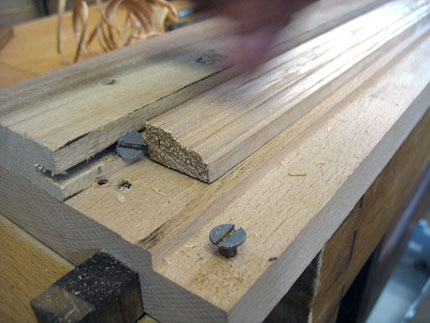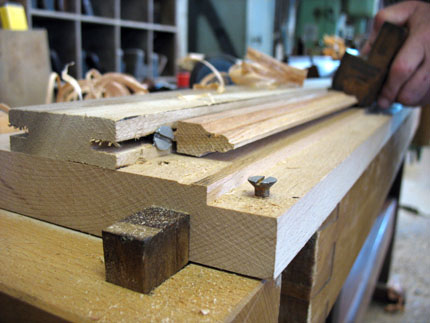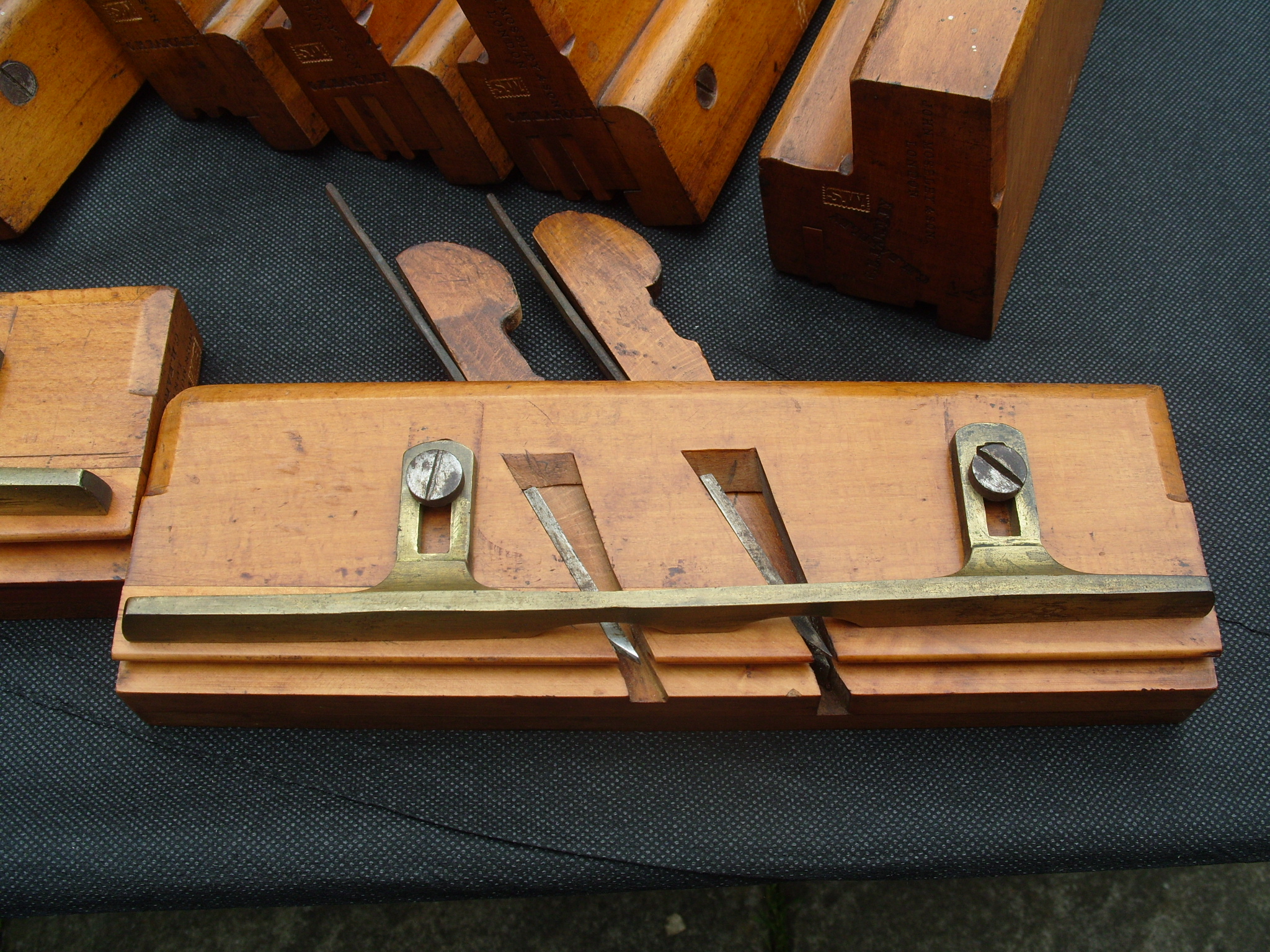
Another name that comes up frequently in tool sales is, of course, Christopher Gabriel. For those wishing to read in detail about the planemaker, I can do no better than refer to the excellent book, Christopher Gabriel and the Tool Trade in 18th Century London by Jane and Mark Rees. There is also a great set of papers on Gabriel on Google Books, Eighteenth Century Woodworking Tools by James.M.Gaynor. However, I recently stumbled on the article below, which gives a good abbreviated account of his career.
(This article was scanned from the July 1994 issue of ToolTalk.)
The story of Christopher Gabriel is the traditional tale of the poor boy who made good. Christopher was born on April 2, 1746, in Falmouth, a coastal town in Cornwall, England. Falmouth is a small town at the furthest southerly tip of Great Britain, near Land’s End. The record is not absolutely clear, but it is almost certain that his parents were Thomas Gabriel and Jane Hocking who are known to have been married in Falmouth on July 31, 1742. (That Christopher named his first son Thomas as was the tradition in those days, provides additional evidence that Thomas was his father.)
The boy, Christopher, grew up in Falmouth and was given an education which seems to have been adequate for the times. He attended school through age twelve, which would, now-a-days, be considered to be through grade school.(ref 1) Christopher also received religious instruction but it seems that at first he was little interested in it. There is a report that his mother was upset that he did not take to religion and she used to cry over him.(ref 2) There is still in existence in the family, Christopher’s exercise book in which he has written “Christopher Gabriel his Book”. In an updated entry he wrote that he tried “to avoid Public Worship with idle excuses.” Church services in those days took stamina, often lasting from morning to night with breaks for lunch and dinner. His exercise book, for example, has these notations, “30th May, 1756, went to church in the morning, Rev. Mr. Walters preached on Romans Ch. 1. Went to church in afternoon, he preached on Romans Ch. 12” and, he concludes with the comment that in the evening, “Rev. Mr. Walker preached on Jeremiah Ch. 9”.(ref 3) Mother need not have worried because Christopher ultimately became quite a devout Methodist. Every Sunday he would walk the 30 mile round trip to the neighboring village of St Agnes to attend church.
Shortly before he turned thirteen, which would have been about 1759 (no child labor laws then), he was apprenticed to a local master carpenter, recorded as Mr. Barnicot (ref 4) Apparently the master trained this apprentice well, as we can assume by Christopher’s later successes. The apprenticeship, of which we know very little was, apparently, routine. It ended in 1766 coinciding with the time Christopher turned 20 and which was also the end of the usual seven year term of a carpenter’s apprentice.
Christopher continued to live in Falmouth for 2 more years before the call of the big city became irresistible and he decided to try his luck in London (ref 5). One can but wonder if there are any Gabriel/Falmouth planes in existence or if he took up this trade after his move to London. Near the end of 1768 or the first of ’69, Christopher left Falmouth on foot He walked the nearly 200 miles to London, carrying everything he owned in a sack. A London newspaper article of about 1857 tells that Christopher, “came from Cornwall to seek his fortune in the great City whose streets were fabled to be paved with gold.”
Christopher had no sooner arrived in London than he met Alice Trowell who was very soon to become his wife, She had been born on June 24, 1743 in Soham, Cambridgeshire, living on a farm about nine miles out of town from the time she was ten until her father’s death seven years later. Alice had four years of schooling and could read and write well. (ref 6)
Christopher and Alice apparently met through their common interest in the teachings of John Wesley, founder of the Methodist Church. It must have been a whirlwind romance because they were married in March of 1769 at St. John’s church, Clerkenwell. They set up house on Albermarie Street, Clerkenwell, and by the first of 1770, Gabriel began his business of planemaking. It has been speculated that Gabriel took over the shop of John Cogdell (ref 7). He prospered as a planemaker and lumber merchant over the next forty years.
Gabriel had some savings and he borrowed additional capital from his in-laws. He started his business in early 1770 with an investment of £ 131,1,8, On June 30, 1770 Gabriel’s responsibilities increased when his eldest child, Thomas, was born at home. Then came Christopher Junior in 1773 and Edward in 1779. There were also six children who died in infancy (ref 8).
The business did well. In 1774 Gabriel moved to a house in Golden Lane, London and in 1779 he moved again to a home he describes as “the new house built this year in Ould Street, valued at £320. (ref 9)
Business continued to prosper. On the day after his eldest son’s 21st birthday, Gabriel made up a summary of his net worth and he had accumulated what was for those days quite a fortune.
This account still exists and reads as follows: ACCOUNT OF PROPERTY JULY 1, 1791 (ref 10)
Book Debts £ 975, 1, 6
Beach (lumber?) in warehouses in Ironmonger Row
and New Street with labor to debtor £468, 8, 0
Saw, Turkey Stone (Sharpening stone),
Edge Tools & made up work £304, 18, 4
Cultivated Wood, etc, in Old Street £41, 18, 10
Cash in House £80, 0, 0
Household Goods & Wearing apparel £126, 0, 0
Utensils and implements in trade £60, 0, 0
Estate in Old Street £346, 0, 0
do. in Ironmonger Row £90, 0, 0
do. in Connan Street £285, 0, 0
do. in Thames Street £1100, 0, 0
Rents from ditto due to Midsummer £34, 0, 0
£ 3911, 6, 8
Due to creditors £446, 16, 10
——————-
£ 3444, 9,
Gabriel was making quite a name for himself. His planemaking business was then located at 32 Banner Street, Golden Lane. The following year he purchased a house in Banner Street for £370,9,6 and in 1793 he purchased the house next door for £200.11 While no other records are at hand regarding Gabriel’s property dealings, his Last Will and Testament lists 27 houses and commercial buildings. At the time of his will (Nov. 20, 1806) Gabriel recited that he lived in the Parish of Cripple gate, Bridgewater Square, London. This is the same neighborhood where the earliest known London planemakers, Thomas Granford & Robert Hemmings, are recorded12 To give the reader a picture of the value of money in those days, Gabriel left his sister a life income of £10 a year and his sister in law £5 a year but to be doubled if she was ever widowed13 Christopher Gabriel died in 1809, survived by his wife and three sons. His wife outlived him by only four months.
By April 10, 1798, Gabriel had taken his sons Thomas and Christopher, Jr. into the business which ultimately expanded into a busy lumber wholesale and importing business. The third son, Edward, was apprenticed to a goldsmith. In the early 19th century, the planemaking end of the business ceased and the family business was focused on the timber business at a location known as Gabriel’s Wharf, which was located across the Thames from the Tower of London between what are now the Waterloo and Blackfriars bridges. Ultimately the timber business included a fleet of barges and was a very successful operation. After Gabriel’s death, the business operated under the name of Thomas Gabriel’s and Sons, then as Thomas Gabriel Sons & Burton and was then located on Commercial Road, Lambeth. It survived until 1968 as Gabriel, Wade & English, Ltd. when it was bought out by a conglomerate.14
The family which descended from Christopher Gabriel became quite prominent in England and his grandson, Sir Thomas Gabriel (a member of the Goldsmiths family) became, first, the Sheriff of London and Middlesex in 1859 and the Lord Mayor of London in the years 1866-67.15 The name of Gabriel is still prominent in the news but in a way which could never have been imagined by old Christopher. The current international rock star, Peter Gabriel is a direct descendant from his planemaker ancestor.
Gabriel was an extremely prolific planemaker. It is amazing how many examples made by this 18th century maker are still to be found. Gabriel made good quality tools and according to Mr. Goodman, he was the innovator of several new plane designs.16 In this man’s opinion, every wooden plane collection should have at least one Gabriel plane: they are still available at reasonable prices, and it is a real pleasure to hold a 200 year old plane in your hands while you contemplate the life and times of Christopher Gabriel.
At Hackney Tools, we buy old, good quality woodworking tools. If you have any tools you would like to sell, please get in touch using the contact form on the home page.
Notes:
1. Genealogical research by Douglas B.G. Gabriel
2. Ibid
3. This book is in the possession of Christopher P. (Kit) Gabriel of Falmouth
4. Genealogical research. op. cit.
5. Ibid
6. Biographical letter by Alice Gabriel, found after her death in 1800, letter now in possession of Douglas B.G. Gabriel
7. Goodman, “British Plane Makers from 1700.” Page 20
8. Genealogical research, op. cit.
9. Ibid
10. Ibid
11. Ibid
12. Carter, “British Plane Makers Before 1700”. EAIA Journal, June 1983
13. Copy of Last Will & Testament in possession of Muriel Gabriel Heltzel
14. Timber Trade: Journal (British) August 15, 1970
15. (London) The Morning Chronicle various 1866 dates
16. Goodman, “Stock Inventories, Gabriel & Sons, London 1791 & 1793 Chronical, June 1984
